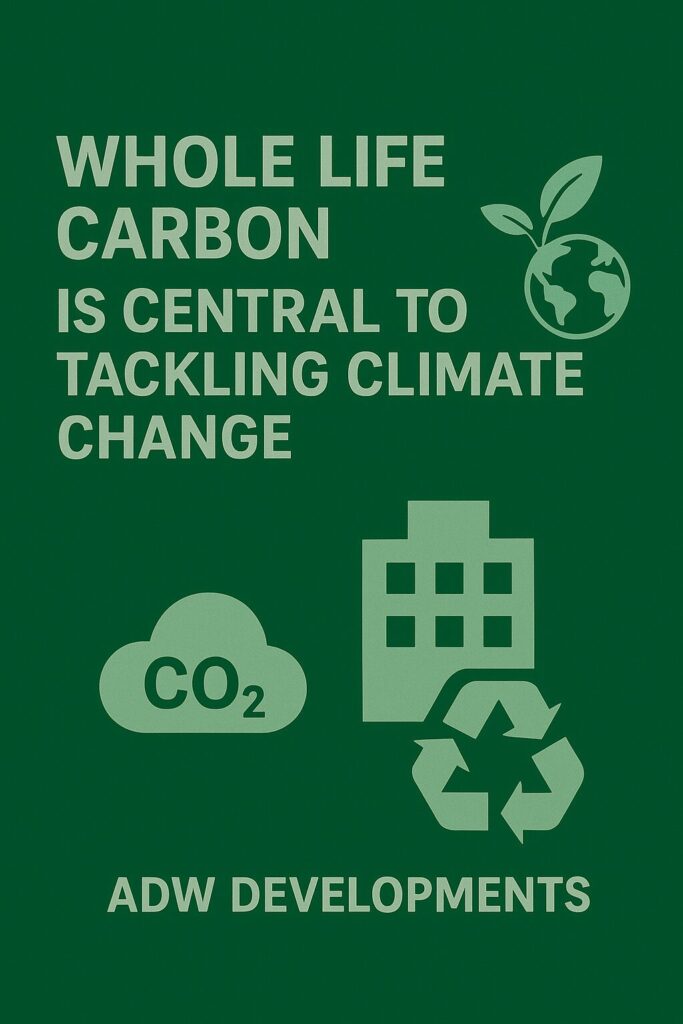Whole Life Carbon (WLC) is central to tackling climate change within the built environment. As we’ve explored in previous , it accounts for all greenhouse gas (GHG) emissions associated with a building or infrastructure project, ranging from the extraction of raw materials to construction, operation, and eventual reuse or demolition.
By understanding and managing WLC, we can make smarter, more sustainable decisions that reduce emissions and support a truly circular economy.
This article explores the importance of Whole Life Carbon, outlines its key components, and highlights how effective analysis can drive innovation, sustainability, and resilience throughout the built environment.
What Is Whole Life Carbon and Why Does It Matter?
Whole Life Carbon refers to the total GHG emissions produced by a built asset throughout its entire lifespan. This includes:
- Embodied Carbon: Emissions from material extraction, manufacturing, transportation, and construction.
- Operational Carbon: Emissions generated during use, such as heating, cooling, lighting, and ventilation.
- End-of-Life Carbon: Emissions associated with demolition, disposal, or material recovery and recycling.
Taking this comprehensive approach is vital. Focusing solely on operational carbon, while important, overlooks a substantial proportion of a building’s total environmental footprint. As modern buildings become increasingly energy efficient, embodied carbon represents a growing share of lifecycle emissions.
Considering Whole Life Carbon therefore enables a truly holistic understanding of environmental impact, identifying key emission hotspots and supporting targeted strategies for reduction at every stage.

The Role of Whole Life Carbon Analysis in a Sustainable Future
Whole Life Carbon analysis is far more than an academic exercise — it is a practical framework for delivering real-world change. By assessing emissions from ‘cradle to grave’, professionals across the construction sector can:
- Inform Design Decisions
Early-stage WLC assessments guide material selection, structural design, and construction methods to minimise embodied carbon. Choosing recycled materials or low-carbon alternatives, for example, can significantly reduce upfront emissions. - Optimise Operational Efficiency
WLC reinforces the importance of energy-efficient design, renewable energy integration, and smart building systems to reduce in-use emissions. - Promote Circular Economy Principles
By designing for deconstruction and prioritising material reuse, WLC analysis supports circular economy goals, reducing waste and keeping valuable resources in circulation. - Facilitate Policy and Market Shifts
The increasing focus on WLC is influencing both regulation and market behaviour. Projects that demonstrate carbon reduction leadership are better positioned to meet compliance standards and attract sustainability-driven clients. - Enable Data-Driven Decision-Making
Reliable data and digital tools allow project teams to model carbon impacts, track progress, and transparently demonstrate their environmental performance.
Aligning Environmental and Economic Drivers: The Role of Life Cycle Costing
Transitioning towards sustainable technologies and materials requires careful alignment of both environmental and financial objectives. Life Cycle Costing (LCC) plays a pivotal role in this process, providing a comprehensive view of a project’s economic performance over its entire lifespan, from construction and operation to maintenance and end-of-life.
By pairing WLC with LCC, decision-makers can evaluate not only the environmental benefits but also the long-term economic value of sustainable choices, ensuring financial resilience alongside carbon reduction.
Empowering Change Through Accurate Tools and Data
Knowledge is only powerful when paired with action. Reliable Whole Life Carbon tools help professionals model impacts, identify reduction opportunities, and integrate sustainability throughout a project’s lifecycle. With accurate data driving decisions, sustainability shifts from ambition to everyday practice, shaping how we design, build, and operate.
FAQs
Why is Whole Life Carbon analysis increasingly important?
As operational emissions decline through efficiency improvements, embodied carbon now represents a larger share of total emissions. WLC analysis helps address this balance comprehensively.
How does WLC support the circular economy?
It encourages design for deconstruction, material reuse, and recycling, reducing waste and preserving resources.
What is the role of financial analysis?
Life Cycle Costing ensures sustainable decisions make sense economically, aligning long-term value with environmental goals.
Where can I find reliable tools and resources?
WholeLifeCarbon.com provides insights, tools, and expert guidance to support accurate assessment and sustainable best practice.
Take Action: Build a Greener Future with ADW Developments
At ADW Developments, we help clients identify opportunities for innovation, make informed decisions, and create truly circular, low-carbon projects. Contact our experts to learn how we can help you achieve your sustainability goals. From strategy through to delivery.
